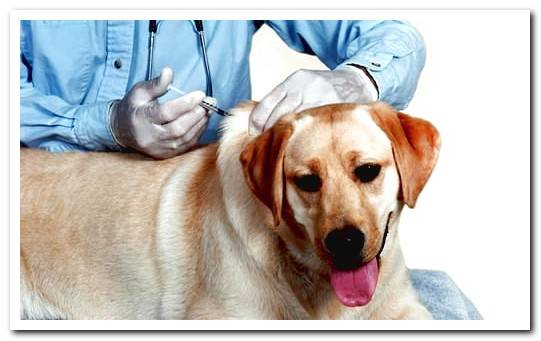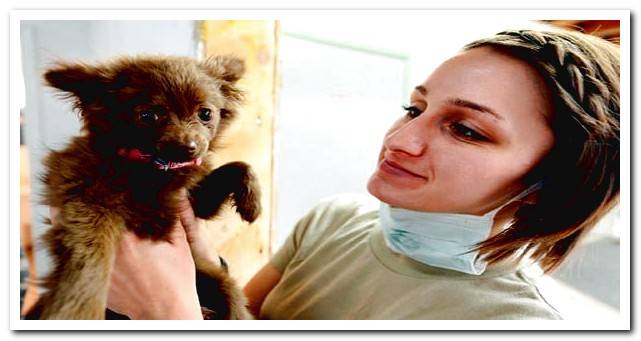
We tend to think that more severe diseases are more common in older ages. However, puppies are especially vulnerable to certain diseases and if they are not properly treated they can be fatal.
In this post we summarize what those deadly pathologies are and how you can prevent and treat them. Can you come with us?
Index of contents
- 1 Chronic renal failure
- 2 Distemper’s disease or distemper
- 3 Canine Parvovirus
- 4 Leptospirosis
- 5 Canine coronavirus
- 6 Dirofilariosis
- 7 Cancer
Chronic renal failure
It is a pathology typical of elderly dogs and is characterized by:
- Weightloss.
- Coat in poor condition.
- Increased sensation of thirst and / or urination.
- Hypertension.
- Anemia.
- Bad breath.
- Presence of proteins in the urine (proteinuria).
- Decrease in blood potassium (hypokalemia).
- Increased phosphates (hyperphosphatemia).
You should know that in this particular condition, food plays a determining role. Therefore, the supply of sodium and protein must be restricted and water must be provided on demand.

Distemper’s disease or distemper
Also called Carré disease, it is caused by morbillivirus that is inhaled through a multitude of aerosols.
It can also affect other species such as foxes, wolves, coyotes or big cats, but in the case of dogs it is especially virulent with puppies between 3 and 6 months old.
It is a systemic disease that damages the respiratory system, the ganglia and even the nervous system.
It produces secretion in the eyes, vomiting, diarrhea, body temperature above 40º, nasal discharge, reproductive disorders, inappetence, optical injuries and rheumatoid arthritis.
Its treatment is similar to that indicated for Parvovinosis.
Canine Parvovirus
It is a highly contagious condition that, although it can manifest itself at any age, is usually most recurrent in puppies. It is produced by inhalation of the virus through the feces contaminated by the virus parvovirus from another dog. In case of infection, your pet will show the following symptoms:
- Bloody diarrhea.
- Vomiting
- Fever.
- Dehydration
- Apathy.
- Loss of appetite
- Drop in the percentage of leukocytes in the blood.
In some cases, the virus can reach the bacteria in the microbiota and generate a secondary bacterial infection that will require antibiotics to reverse it.
Its early detection is essential to distinguish it from the coronavirus, rotavirus, bacterial enteritis, canine distemper and of costridiosis. Only then will it be possible to prescribe the appropriate treatment.
The therapeutic action will try to mitigate the symptoms, since there is no cure. In this sense, antiemetics will be used to alleviate vomiting, antidiarrheals and hemostats to contain bleeding.
Prevention is the best treatment, so keep your immunization schedule and provide it with adequate hygiene and disinfection.
Leptospirosis
This contagious disease is transmitted through rats by the leptospine bacteria. Did you know that its presence in the urine can remain even 2 months after healing the dog?
Its symptoms evolve rapidly and in the most severe stages mortality increases considerably. In addition to hyperthermia, vomiting and diarrhea, kidney and liver failure, nasal congestion and muscle pain are its main manifestations.
For their treatment, antibiotics and analgesics will be incorporated, in addition to antiemetics and antidiarrheals.
As a tip, try to prevent your pet from smelling the urine of other dogs that could be carriers.

It is a highly contagious viral intestinal infection by the feco-oral route, with puppies being the most susceptible to contracting it. The virus affects cells located in the microvilli of the small intestine canceling its operation and weakening the immune system.
To the symptoms mentioned in the two previous sections, we must add the pain caused by intestinal inflammation that incapacitates the dog to continue with a normal life.
The treatment includes an abundance of liquids to stop dehydration, antiemetics and antidiarrheals, as well as a nutritious diet and prokinetics to regulate intestinal transit.
Dirofilariosis
The cause of this serious disease is the worm Dirofilaria immitis and it is recurrent in the Mediterranean basin, given that the climatic conditions of this region are ideal for its proliferation.
In its most incipient stage, symptoms are barely visible. However, when worms reach the heart or the lungs their severity is already severe and will be evidenced by:
- Difficulty breathing.
- Cough.
- Extreme fatigue
- Hepatic injury.
- Heart failure.
To cope with it, drugs will be necessary to destroy the worms and anticoagulant to prevent thrombi.
To prevent it, avoid walks at sunrise or sunset, given the accumulation of mosquitoes in these time zones, and use pipettes, necklaces or ultrasonic devices to repel the proximity of parasites according to the criteria of your vet.
Cancer
From 10 years of age, the risk of your dog developing cancer increases markedly.
20% of canine cancer patients, regardless of race, have lymphoma.
Hermangiosarcoma or cancer in the cells that line the blood vessels, breast carcinoma in non-sterilized bitches, osteosarcoma or melanoma are other variants. that cause more deaths among canids.
In short, ensuring that your pet receives vaccines according to its calendar, that its environment is clean and disinfected are the main guidelines that will bri
ng you closer to a healthy and long-lived dog.
